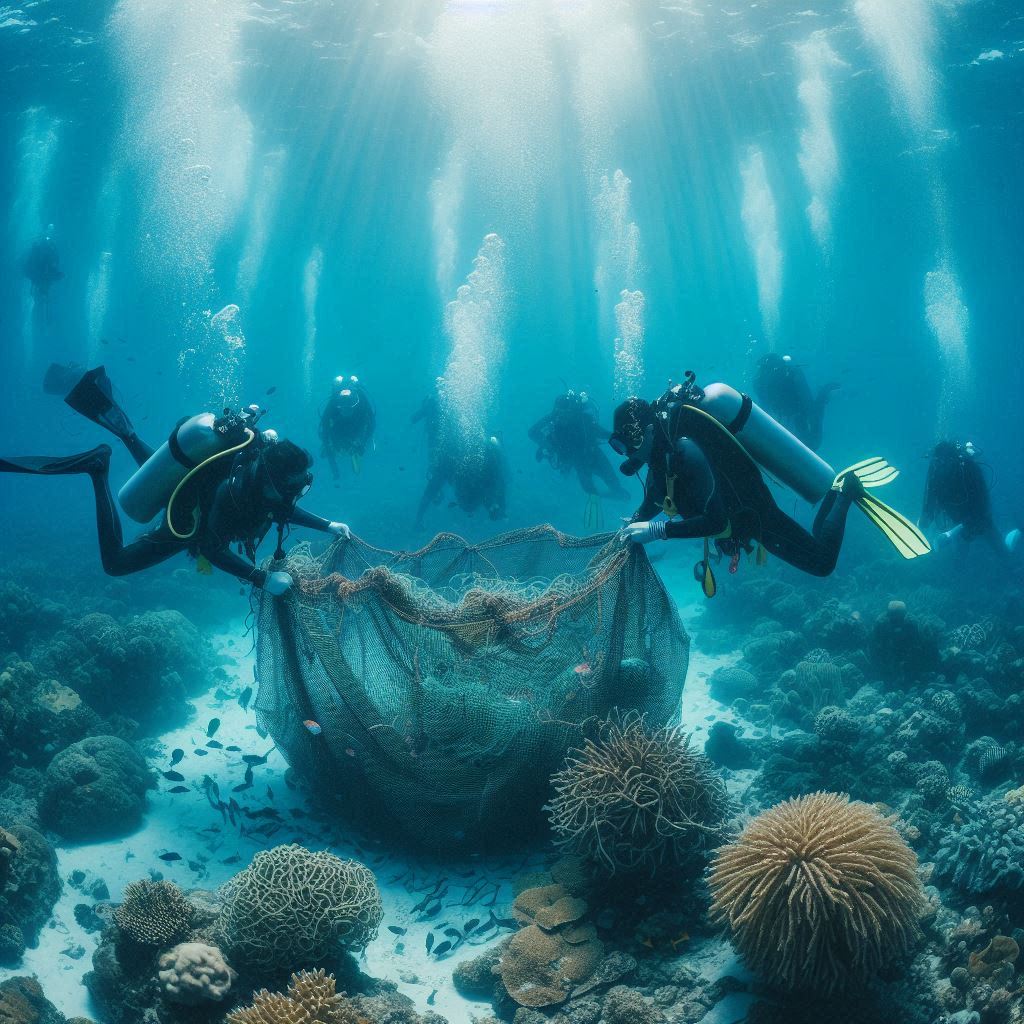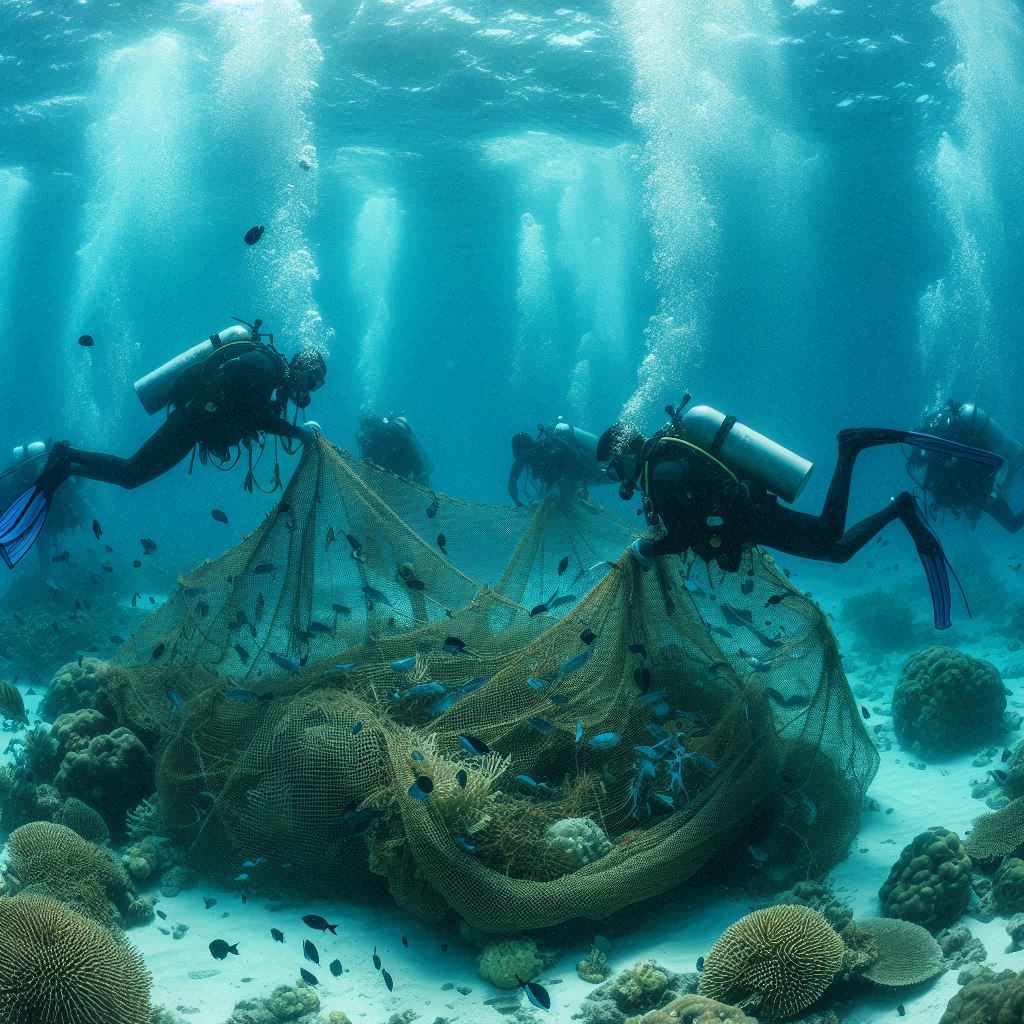Imagine walking along a beautiful coastline, only to discover tangled ghost nets washed ashore, silent killers from the deep. Ghost fishing, caused by abandoned ghost gear, threatens Nigeria’s marine life, trapping fish and endangering entire ecosystems.
But here’s the thing—this hidden menace doesn’t have to continue.
In this article, I’m going to share how ghost fishing gear wreaks havoc under the surface and what you can do to help prevent it.
Let’s get into it.
What is Ghost Fishing?
Ghost fishing is a term that sounds eerie—and for good reason. It describes what happens when fishing gear, like nets and traps, is abandoned or lost in the ocean. These ghost nets and other ghost gear don’t just disappear; they continue to do exactly what they were designed to do—catch and kill marine life.
But here’s where it gets even more troubling: this ghost fishing gear can drift through the ocean for years, ensnaring fish, turtles, dolphins, and even seabirds. The marine creatures that get caught often suffer slow, painful deaths, and the cycle doesn’t end there.
As the ghost net or gear fills up, it may sink to the bottom, where it can destroy coral reefs and other crucial habitats. Eventually, it may resurface, and the killing starts all over again.
Ghost fishing is an invisible enemy, wreaking havoc on marine ecosystems without any human oversight. It’s not just a problem for the environment but also for the fishing industry. When fish stocks are depleted by ghost fishing, it directly impacts the livelihoods of communities that rely on these resources.
Understanding Ghost Fishing in Nigeria
Ghost fishing is a global issue, but its impact on Nigeria’s marine environment is particularly alarming. With a coastline stretching over 850 kilometers, Nigeria’s waters are rich in biodiversity and provide livelihoods for countless coastal communities. However, the rising problem of ghost fishing threatens to disrupt this delicate balance.
In Nigeria, ghost fishing occurs when fishing gear, like ghost nets and traps, are lost or abandoned at sea. These ghost nets continue to trap marine life, including commercially important species like fish and crustaceans, but they also ensnare endangered species such as sea turtles and dolphins.
As these ghost fishing gears drift through Nigerian waters, they become lethal hazards that silently kill marine life, often without the knowledge of the very fishermen who lost them.
The issue is compounded by Nigeria’s thriving fishing industry, where the use of nets is widespread. When these nets are lost due to storms, accidents, or improper disposal, they transform into ghost nets that wreak havoc on marine ecosystems.
The impact extends beyond the environment; it also affects the livelihoods of local fishermen who find their catch depleted, not realizing that ghost fishing is partly to blame.
Types of Ghost Fishing Gear
Ghost fishing gear comes in many forms, each with its own devastating impact on marine life.
- The most notorious of these is the ghost net—a type of fishing net that gets lost or abandoned in the ocean. These ghost nets, often made of durable synthetic materials, can continue catching fish and other marine animals for years, even decades. They are nearly invisible underwater, making them especially dangerous as they drift through the sea, entangling anything in their path.
But ghost fishing gear isn’t limited to just nets.
- Another common type is the ghost line—fishing lines that break off and float away. These ghost lines can wrap around the necks, fins, and bodies of marine creatures, leading to injury, suffocation, or even death.
- Ghost traps, such as crab pots and lobster traps, are also a significant concern. When these traps are lost, they continue to attract and trap marine life, which then becomes bait for more animals, creating a deadly cycle.
- Even smaller items like hooks, sinkers, and ropes can become ghost gear. While they might seem insignificant, these items can still cause severe harm. For instance, hooks can be swallowed or lodged in the mouths of fish and other sea creatures, leading to infections and slow deaths. Ropes can entangle marine mammals, leading to restricted movement, injury, or drowning.
Impact of Ghost Fishing on Marine Life

Ghost fishing is a silent killer, wreaking havoc on marine life and ecosystems in ways many don’t even realize. When ghost nets and other ghost fishing gear are left to drift in the ocean, they continue to trap marine life indiscriminately.
Local fish species, already vulnerable due to overfishing and habitat loss, find themselves caught in these ghost nets, unable to escape. The result? Entire schools of fish are wiped out, leaving a significant dent in the population.
But the impact of ghost fishing doesn’t stop at fish. Sea turtles, dolphins, sharks, and seabirds are frequently ensnared by ghost fishing gear. These animals suffer immensely, often becoming entangled in ghost nets that cut into their flesh, restrict their movement, and eventually lead to a slow, agonizing death by suffocation or starvation.
In coral reef areas, ghost nets settle on the reefs, smothering the corals and destroying the habitat that countless marine species depend on. According to the World Wildlife Fund, ghost gear is responsible for killing and injuring hundreds of thousands of marine animals every year.
One stark example of ghost fishing’s devastating effects can be found in the waters off the coast of Nigeria. Fishermen have reported finding ghost nets loaded with the bodies of trapped fish, crabs, and even the occasional sea turtle.
These nets, often swept away during storms or left behind due to equipment failure, continue to fish long after their intended use, decimating local marine life.
The loss of these animals has a cascading effect on marine ecosystems. When top predators like sharks are caught in ghost nets, it disrupts the balance of the entire food chain, leading to overpopulation of some species and the decline of others. This imbalance can cause long-term damage to the ecosystem, making it harder for marine environments to recover and thrive.
Economic and Social Consequences of Ghost Fishing
Ghost fishing doesn’t just harm marine life; it also has serious economic and social consequences, particularly for local fishing communities.
- When ghost nets and other ghost fishing gear are left in the ocean, they continue to trap fish, which directly reduces the number of fish available for local fishermen. For communities that rely heavily on fishing as a source of income and food, this can be devastating. In Nigeria, for example, fishing is a vital part of many coastal communities’ livelihoods. The continued presence of ghost nets in the waters means that fewer fish are caught in traditional fishing methods, leading to a decrease in income for local fishermen.
- This reduction in catch not only affects the fishermen but also impacts the entire supply chain, from those who process the fish to those who sell it in local markets. The economic impact of ghost fishing can ripple through entire communities, leading to increased poverty and food insecurity.
- Moreover, ghost fishing gear also damages the very ecosystems that fishermen depend on. Coral reefs, which are essential habitats for many fish species, can be destroyed by ghost nets, further reducing fish populations. This environmental degradation makes it even harder for local fishermen to sustain their livelihoods, forcing some to abandon fishing altogether.
- The social consequences are just as severe. As traditional livelihoods become less viable, many people are forced to migrate to urban areas in search of work, leading to the erosion of cultural practices and community structures.
Current Efforts and Challenges
Tackling ghost fishing in Nigeria is an uphill battle, but several conservation initiatives are making strides in the right direction.
Organizations like the Nigerian Conservation Foundation (NCF) and Global Ghost Gear Initiative (GGGI) are actively working to address the issue by raising awareness, advocating for better waste management practices, and organizing cleanup efforts to remove ghost nets and other ghost fishing gear from the ocean.
However, the challenges are significant. One of the biggest hurdles is the sheer scale of the problem. Ghost fishing gear is often difficult to track and retrieve, especially in Nigeria’s vast and remote coastal waters.
Also, limited resources and funding make it challenging for conservation groups to sustain long-term efforts. Many local communities lack the necessary tools and training to effectively deal with ghost gear, leading to its continued presence in the ocean.
Another challenge is the lack of enforcement of existing regulations. While there are laws in place to prevent illegal dumping of fishing gear, enforcement is often weak due to corruption, lack of surveillance, and inadequate penalties.
Furthermore, many fishermen are not fully aware of the long-term impact of ghost fishing gear on marine ecosystems and their livelihoods, making education and outreach crucial but difficult to implement.
Despite these challenges, progress is being made. Initiatives like the Ocean Conservancy’s International Coastal Cleanup are helping to mobilize volunteers and local communities to take action. Innovative solutions, such as biodegradable fishing nets and improved gear recovery programs, are also being explored to reduce the amount of ghost gear in the ocean.
What Can Be Done?
Addressing ghost fishing requires a multi-pronged approach, and everyone has a role to play. Here’s what can be done to tackle this pressing issue:
1. Implement Better Waste Management:
One key solution is improving waste management practices to prevent ghost fishing gear from entering the ocean in the first place. Initiatives like The Ocean Cleanup focus on developing technologies to collect and remove floating ghost nets and other debris.
2. Support and Develop Biodegradable Gear:
Switching to biodegradable fishing gear can significantly reduce the long-term impact of ghost fishing. Research and investment in materials that decompose naturally could lessen the persistence of ghost nets and other ghost fishing gear in the ocean.
One of the best ways to fight ghost fishing is by using better equipment. Tools like the 13 Fishing Freefall Ghost are designed to reduce the chances of losing gear.
They help ensure that your nets and lines don’t end up drifting away and becoming ghost nets. Investing in high-quality, reliable gear can make a big impact.
Also, take good care of your fishing gear. Regularly check and repair it to prevent it from getting lost or abandoned. When it’s time to replace old equipment, dispose of it properly.
3. Strengthen Regulations and Enforcement:
Effective regulation and enforcement are crucial. Governments need to implement stricter laws on the disposal of fishing gear and increase penalties for violations.
Collaborations with organizations like Global Ghost Gear Initiative (GGGI) help in advocating for and developing these policies.
4. Community Involvement and Education:
Local communities play a vital role in tackling ghost fishing. Awareness campaigns and education programs can teach fishermen about the impact of ghost fishing and proper gear disposal.
Community-led initiatives, supported by groups such as Nigerian Conservation Foundation (NCF), can mobilize local action to retrieve lost gear and prevent further pollution.
5. Develop Gear Recovery Programs:
Establishing programs for retrieving lost and abandoned gear can make a big difference. This includes organizing clean-up events and using technology like underwater drones to locate and remove ghost fishing gear.
Bottom Line
Ghost fishing is a pressing issue that affects marine ecosystems around the world. Knowing the impact of ghost gear, such as ghost nets and abandoned fishing equipment can help us take meaningful steps to prevent and address the problem.
From upgrading to advanced gear to participating in cleanup efforts and promoting sustainable practices, every action counts.
Together, we can reduce the impact of ghost fishing, protect marine life, and preserve the health of our oceans. This way, we contribute to a cleaner, safer environment for both sea life and future generations.
